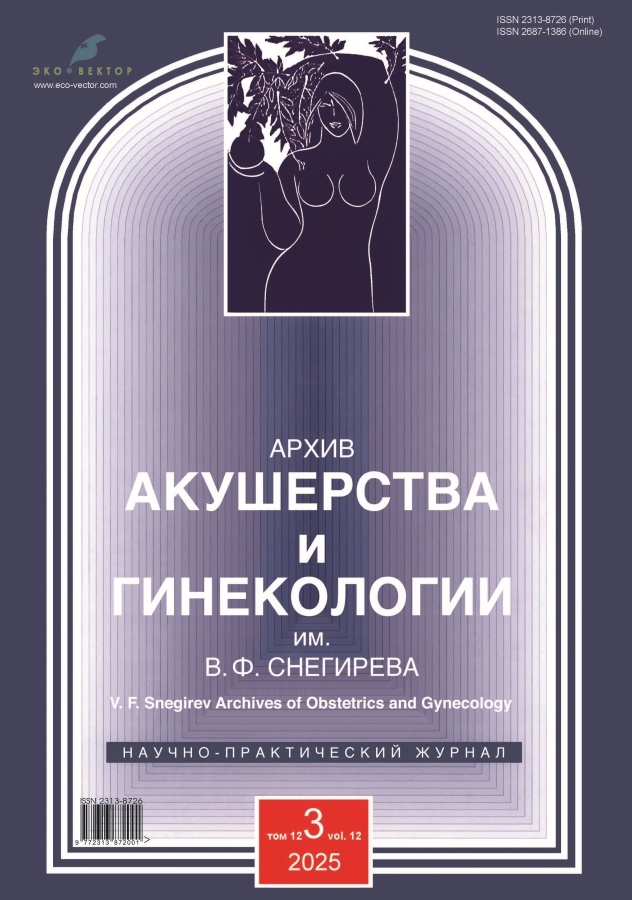ROR1跨膜受体作为子宫内膜癌治疗靶点
- 作者: Skossyrskiy V.S.1, Gilmutdinova I.I.1, Boot M.S.1, Zelenchenkova P.I.1, Kimutsadze V.V.1, Kimutsadze V.V.1, Svidinskaya E.A.1, Ageev M.B.1, Sosnova E.A.1
-
隶属关系:
- I.M. Sechenov First Moscow State Medical University
- 期: 卷 12, 编号 3 (2025)
- 页面: 285-294
- 栏目: Reviews
- URL: https://bakhtiniada.ru/2313-8726/article/view/350241
- DOI: https://doi.org/10.17816/aog677746
- EDN: https://elibrary.ru/ZZZDKZ
- ID: 350241
如何引用文章
详细
子宫内膜癌仍是女性生殖系统中最常见的恶性肿瘤之一。尽管诊断和治疗手段不断进步,但该病的侵袭性亚型仍表现出较高的转移率、复发率及较低的总生存率,这凸显了探索新型治疗靶点的必要性。其中一种具有前景的分子靶点是酪氨酸激酶样孤儿受体1(receptor tyrosine kinase-like orphan receptor 1 (ROR1),该受体通常仅在胚胎组织中表达,但在多种癌症中(包括子宫内膜癌)被重新激活。
ROR1参与PI3K/Akt/mTOR, MAPK, Wnt/β-catenin等关键信号通路的激活,调控细胞增殖、凋亡、侵袭以及上皮–间质转化。ROR1的高表达与不良的临床病理特征相关,包括较高的肿瘤分级、晚期FIGO分期以及总生存率下降。此外,ROR1通过激活Bcl-2家族的抗凋亡蛋白并维持炎性微环境信号,有助于化疗耐药性的形成。
本文详细探讨了ROR1的分子作用机制、其在子宫内膜癌发生与进展中的作用,以及其作为预后生物标志物和治疗靶点的潜力。同时介绍了靶向治疗的最新进展,包括抗体偶联药物如Zilovertamab vedotin的应用及其在临床实践中的前景。鉴于ROR1在子宫内膜癌发病机制中的关键作用,对其进行抑制可能成为克服耐受性、改善侵袭性子宫内膜癌患者预后的个体化治疗策略的基础。
关键词
作者简介
Vladislav S. Skossyrskiy
I.M. Sechenov First Moscow State Medical University
Email: onco.vlad@gmail.com
ORCID iD: 0000-0002-3417-2359
SPIN 代码: 6910-0652
俄罗斯联邦, 8 Trubetskaya st, bldg 2, Moscow, 119991
Ilsina I. Gilmutdinova
I.M. Sechenov First Moscow State Medical University
Email: ilsinagilmutdinova815@gmail.com
ORCID iD: 0000-0002-7215-5066
俄罗斯联邦, 8 Trubetskaya st, bldg 2, Moscow, 119991
Maxim S. Boot
I.M. Sechenov First Moscow State Medical University
Email: but_mc@mail.ru
ORCID iD: 0009-0000-8468-2106
SPIN 代码: 1292-2693
俄罗斯联邦, 8 Trubetskaya st, bldg 2, Moscow, 119991
Polina I. Zelenchenkova
I.M. Sechenov First Moscow State Medical University
Email: zelenchenkovapi@yandex.ru
ORCID iD: 0000-0002-9491-318X
SPIN 代码: 8553-3232
俄罗斯联邦, 8 Trubetskaya st, bldg 2, Moscow, 119991
Valeriia V. Kimutsadze
I.M. Sechenov First Moscow State Medical University
Email: lerunya-999@mail.ru
ORCID iD: 0009-0001-4084-3921
俄罗斯联邦, 8 Trubetskaya st, bldg 2, Moscow, 119991
Veronika V. Kimutsadze
I.M. Sechenov First Moscow State Medical University
Email: veronika_kimutsadze@mail.ru
ORCID iD: 0009-0006-7791-4881
俄罗斯联邦, 8 Trubetskaya st, bldg 2, Moscow, 119991
Evgeniia A. Svidinskaya
I.M. Sechenov First Moscow State Medical University
编辑信件的主要联系方式.
Email: svidinskaya@gmail.com
ORCID iD: 0000-0002-2368-1932
SPIN 代码: 3002-6388
MD, Cand. Sci. (Medicine)
俄罗斯联邦, 8 Trubetskaya st, bldg 2, Moscow, 119991Mikhail B. Ageev
I.M. Sechenov First Moscow State Medical University
Email: mikhaageev@yandex.ru
ORCID iD: 0000-0002-6603-804X
SPIN 代码: 3122-7420
MD, Cand. Sci. (Medicine), Associate Professor
俄罗斯联邦, 8 Trubetskaya st, bldg 2, Moscow, 119991Elena A. Sosnova
I.M. Sechenov First Moscow State Medical University
Email: sosnova-elena@inbox.ru
ORCID iD: 0000-0002-1732-6870
SPIN 代码: 6313-9959
MD, Dr. Sci. (Medicine), Professor
俄罗斯联邦, 8 Trubetskaya st, bldg 2, Moscow, 119991参考
- Crosbie EJ, Kitson SJ, McAlpine JN, et al. Endometrial cancer. Lancet. 2022;399(10333):1412–1428. doi: 10.1016/S0140-6736(22)00323-3
- Zhang G, Nie F, Zhao W, et al. Comparison of clinical characteristics and prognosis in endometrial carcinoma with different pathological types: a retrospective population-based study. World J Surg Oncol. 2023;21(1):357. doi: 10.1186/s12957-023-03241-0
- Resnick KE, Hampel H, Fishel R, Cohn DE. Current and emerging trends in Lynch syndrome identification in women with endometrial cancer. Gynecol Oncol. 2009;114(1):128–134. doi: 10.1016/j.ygyno.2009.03.003
- Aune D, Navarro Rosenblatt DA, Chan DS, et al. Anthropometric factors and endometrial cancer risk: a systematic review and dose-response meta-analysis of prospective studies. Ann Oncol. 2015;26(8):1635–1648. doi: 10.1093/annonc/mdv142
- Fisher B, Costantino JP, Wickerham DL, et al. Tamoxifen for the prevention of breast cancer: current status of the National Surgical Adjuvant Breast and Bowel Project P-1 study. J Natl Cancer Inst. 2005;97(22):1652–1662. doi: 10.1093/jnci/dji372
- Escobedo LG, Lee NC, Peterson HB, Wingo PA. Infertility-associated endometrial cancer risk may be limited to specific subgroups of infertile women. Obstet Gynecol. 1991;77(1):124–128.
- Bokhman JV. Two pathogenetic types of endometrial carcinoma. Gynecol Oncol. 1983;15(1):10–17. doi: 10.1016/0090-8258(83)90111-7
- Liu D, Gunther K, Enriquez LA, et al. ROR1 is upregulated in endometrial cancer and represents a novel therapeutic target. Sci Rep. 2020;10(1):13906. doi: 10.1038/s41598-020-70924-z
- Zhang H, Yan X, Ke J, et al. ROR1 promotes the proliferation of endometrial cancer cells. Int J Clin Exp Pathol. 2017;10(10):10603–10610.
- Henry CE, Llamosas E, Daniels B, et al. ROR1 and ROR2 play distinct and opposing roles in endometrial cancer. Gynecol Oncol. 2018;148(3):576–584. doi: 10.1016/j.ygyno.2018.01.025
- Karachaliou N, Gimenez-Capitan A, Drozdowskyj A, et al. ROR1 as a novel therapeutic target for EGFR-mutant non-small-cell lung cancer patients with the EGFR T790M mutation. Transl Lung Cancer Res. 2014;3(3):122–130. doi: 10.3978/j.issn.2218-6751.2014.03.02
- Borcherding N, Kusner D, Liu GH, Zhang W. ROR1, an embryonic protein with an emerging role in cancer biology. Protein Cell. 2014;5(7):496–502. doi: 10.1007/s13238-014-0059-7
- Dudas J, Ladanyi A, Ingruber J, et al. Epithelial to mesenchymal transition: a mechanism that fuels cancer radio/chemoresistance. Cells. 2020;9(2):428. doi: 10.3390/cells9020428
- Celià-Terrassa T, Kang Y. How important is EMT for cancer metastasis? PLoS Biol. 2024;22(2):e3002487. doi: 10.1371/journal.pbio.3002487
- Yang J, Antin P, Berx G, et al. Guidelines and definitions for research on epithelial-mesenchymal transition. Nat Rev Mol Cell Biol. 2020;21(6):341–352. doi: 10.1038/s41580-020-0237-9
- Syed MA, Bhat B, Wali A, et al. Epithelial to mesenchymal transition in mammary gland tissue fibrosis and insights into drug therapeutics. PeerJ. 2023;11:e15207. doi: 10.7717/peerj.15207
- Fatima I, Barman S, Rai R, et al. Targeting Wnt signaling in endometrial cancer. Cancers (Basel). 2021;13(10):2351. doi: 10.3390/cancers13102351
- McMellen A, Woodruff ER, Corr BR, et al. Wnt signaling in gynecologic malignancies. Int J Mol Sci. 2020;21(12):4272. doi: 10.3390/ijms21124272
- Liu J, Xiao Q, Xiao J, et al. Wnt/β-catenin signalling: function, biological mechanisms, and therapeutic opportunities. Signal Transduct Target Ther. 2022;7(1):3. doi: 10.1038/s41392-021-00762-6
- Li C, Furth EE, Rustgi AK, Klein PS. When you come to a fork in the road, take it: Wnt signaling activates multiple pathways through the APC/Axin/GSK-3 complex. Cells. 2023;12(18):2256. doi: 10.3390/cells12182256
- Lecarpentier Y, Schussler O, Hébert JL, Vallée A. Multiple targets of the canonical WNT/β-Catenin signaling in cancers. Front Oncol. 2019;9:1248. doi: 10.3389/fonc.2019.01248
- Asem MS, Buechler S, Wates RB, et al. Wnt5a signaling in cancer. Cancers (Basel). 2016;8(9):79. doi: 10.3390/cancers8090079
- Liu D, Enriquez L, Ford CE. ROR2 is epigenetically regulated in endometrial cancer. Cancers (Basel). 2021;13(3):383. doi: 10.3390/cancers13030383
- Liu Y, Yang H, Chen T, et al. Silencing of receptor tyrosine kinase ROR1 inhibits tumor-cell proliferation via PI3K/AKT/mTOR signaling pathway in lung adenocarcinoma. PLoS One. 2015;10(5):e0127092. doi: 10.1371/journal.pone.0127092
- Slomovitz BM, Coleman RL. The PI3K/AKT/mTOR pathway as a therapeutic target in endometrial cancer. Clin Cancer Res. 2012;18(21):5856–5864. doi: 10.1158/1078-0432.CCR-12-0662
- Abdelbary AM, Kaf RM, Lashin ME, et al. RON, ROR1 and SUSD2 expression in tissues of endometrial carcinoma patients. Clinicopathological and prognostic implications. Contemp Oncol (Pozn). 2022;26(2):109–122. doi: 10.5114/wo.2022.118245
- Codocedo JF, Inestrosa NC. Wnt-5a-regulated miR-101b controls COX2 expression in hippocampal neurons. Biol Res. 2016;49:9. doi: 10.1186/s40659-016-0071-x
- Zhao C, Bu X, Wang W, et al. GEC-derived SFRP5 inhibits Wnt5a-induced macrophage chemotaxis and activation. PLoS One. 2014;9(1):e85058. doi: 10.1371/journal.pone.0085058
- Hashemi Goradel N, Najafi M, Salehi E, et al. Cyclooxygenase-2 in cancer: A review. J Cell Physiol. 2019;234(5):5683–5699. doi: 10.1002/jcp.27411
- Lombardi F, Augello FR, Artone S, et al. Up-regulation of cyclooxygenase-2 (COX-2) expression by temozolomide (TMZ) in human glioblastoma (GBM) Cell Lines. Int J Mol Sci. 2022;23(3):1545. doi: 10.3390/ijms23031545
- Mori N, Mironchik Y, Wildes F, et al. HIF and COX-2 expression in triple negative breast cancer cells with hypoxia and 5-fluorouracil. Curr Cancer Rep. 2020;2(1):54–63.
- Li M, Li M, Wei Y, Xu H. Prognostic and clinical significance of cyclooxygenase-2 overexpression in endometrial cancer: a meta-analysis. Front Oncol. 2020;10:1202. doi: 10.3389/fonc.2020.01202
- Lyndin M, Kravtsova O, Sikora K, et al. COX2 Effects on endometrial carcinomas progression. Pathol Res Pract. 2022;238:154082. doi: 10.1016/j.prp.2022.154082
- Karvonen H, Barker H, Kaleva L, et al. Molecular Mechanisms Associated with ROR1-Mediated Drug Resistance: Crosstalk with Hippo-YAP/TAZ and BMI-1 Pathways. Cells. 2019;8(8):812. doi: 10.3390/cells8080812
- Menck K, Heinrichs S, Baden C, Bleckmann A. The WNT/ROR Pathway in Cancer: From Signaling to Therapeutic Intervention. Cells. 2021;10(1):142. doi: 10.3390/cells10010142
- Yang J, Wang X, Gao Y, et al. Inhibition of PI3K-AKT Signaling Blocks PGE2-Induced COX-2 Expression in Lung Adenocarcinoma. Onco Targets Ther. 2020;13:8197-8208. doi: 10.2147/OTT.S263977
- Wang Y, Zhang H. Regulation of Autophagy by mTOR Signaling Pathway. Adv Exp Med Biol. 2019;1206:67–83. doi: 10.1007/978-981-15-0602-4_3
- Kim YC, Guan KL. mTOR: a pharmacologic target for autophagy regulation. J Clin Invest. 2015;125(1):25–32. doi: 10.1172/JCI73939
- Adamyan LV, Gevorgyan AP. Autophagy as a new link in the mechanism of development of reproductive system disorders (literature review). Russian Journal of Human Reproduction. 2019;25(5):6–14. doi: 10.17116/repro2019250516
- Zia A, Farkhondeh T, Pourbagher-Shahri AM, Samarghandian S. The role of curcumin in aging and senescence: Molecular mechanisms. Biomed Pharmacother. 2021;134:111119. doi: 10.1016/j.biopha.2020.111119
- Karvonen H, Perttilä R, Niininen W, et al. Wnt5a and ROR1 activate non-canonical Wnt signaling via RhoA in TCF3-PBX1 acute lymphoblastic leukemia and highlight new treatment strategies via Bcl-2 co-targeting. Oncogene. 2019;38(17):3288–3300. doi: 10.1038/s41388-018-0670-9
- Samadder S, Paul P, De A. Crosstalk between cell fate and survival pathways during uterine cervical carcinoma progression: a molecular and clinical perspective. Journal of Cancer Metastasis and Treatment. 2023;9:30.
- Huang J, Shi Y, Li H, et al. Knockdown of receptor tyrosine kinase-like orphan receptor 2 inhibits cell proliferation and colony formation in osteosarcoma cells by inducing arrest in cell cycle progression. Oncol Lett. 2015;10(6):3705-3711. doi: 10.3892/ol.2015.3797
- Bleckmann A, Conradi LC, Menck K, et al. β-catenin-independent WNT signaling and Ki67 in contrast to the estrogen receptor status are prognostic and associated with poor prognosis in breast cancer liver metastases. Clin Exp Metastasis. 2016;33(4):309–323. doi: 10.1007/s10585-016-9780-3
- Lopez-Bergami P, Lau E, Ronai Z. Emerging roles of ATF2 and the dynamic AP1 network in cancer. Nat Rev Cancer. 2010;10(1):65–76. doi: 10.1038/nrc2681
- Piki E, Dini A, Raivola J, et al. ROR1-STAT3 signaling contributes to ovarian cancer intra-tumor heterogeneity. Cell Death Discov. 2023;9(1):222. doi: 10.1038/s41420-023-01527-6
- Wang WZ, Shilo K, Amann JM, et al. Predicting ROR1/BCL2 combination targeted therapy of small cell carcinoma of the lung. Cell Death Dis. 2021;12(6):577. doi: 10.1038/s41419-021-03855-w
- Zhou Q, Zhou S, Wang H, et al. Stable silencing of ROR1 regulates cell cycle, apoptosis, and autophagy in a lung adenocarcinoma cell line. Int J Clin Exp Pathol. 2020;13(5):1108–1120.
- Lee KJ, Kim NH, Kim HS, et al. The Role of ROR1 in Chemoresistance and EMT in Endometrial Cancer Cells. Medicina (Kaunas). 2023;59(5):994. doi: 10.3390/medicina59050994
- Sievers EL, Senter PD. Antibody-drug conjugates in cancer therapy. Annu Rev Med. 2013;64:15–29. doi: 10.1146/annurev-med-050311-201823
- Choi MY, Widhopf GF 2nd, Ghia EM, et al. Phase I trial: cirmtuzumab inhibits ror1 signaling and stemness signatures in patients with chronic lymphocytic leukemia. Cell Stem Cell. 20181;22(6):951–959.e3. doi: 10.1016/j.stem.2018.05.018
- Liu D, Kaufmann GF, Breitmeyer JB, et al. The anti-ROR1 monoclonal antibody zilovertamab Inhibits the proliferation of ovarian and endometrial cancer cells. Pharmaceutics. 2022;14(4):837. doi: 10.3390/pharmaceutics14040837
- Shatsky RA, Batra-Sharma H, Helsten T, et al. A phase 1b study of zilovertamab in combination with paclitaxel for locally advanced/unresectable or metastatic Her2-negative breast cancer. Breast Cancer Res. 2024;26(1):32. doi: 10.1186/s13058-024-01782-0
补充文件









